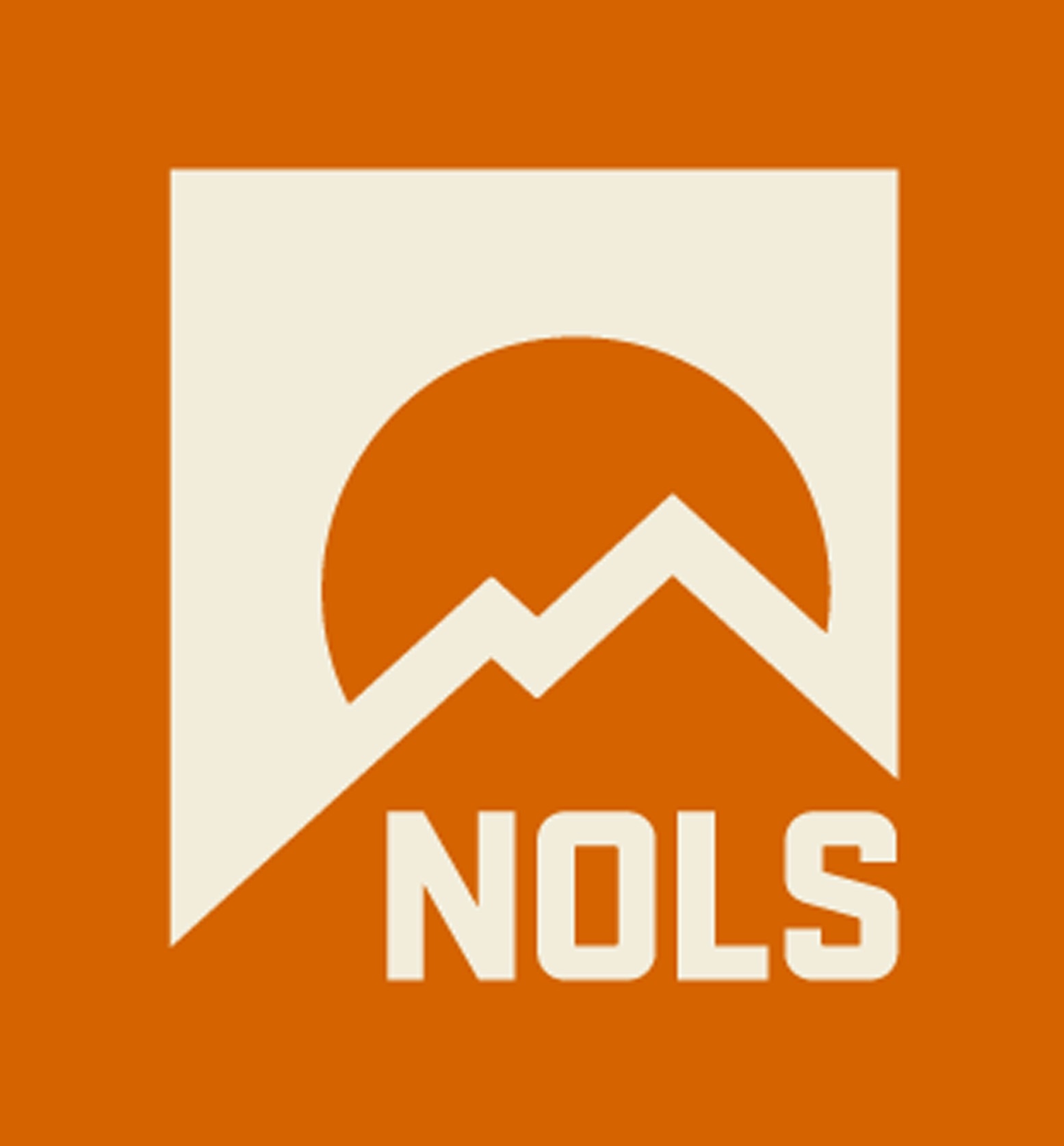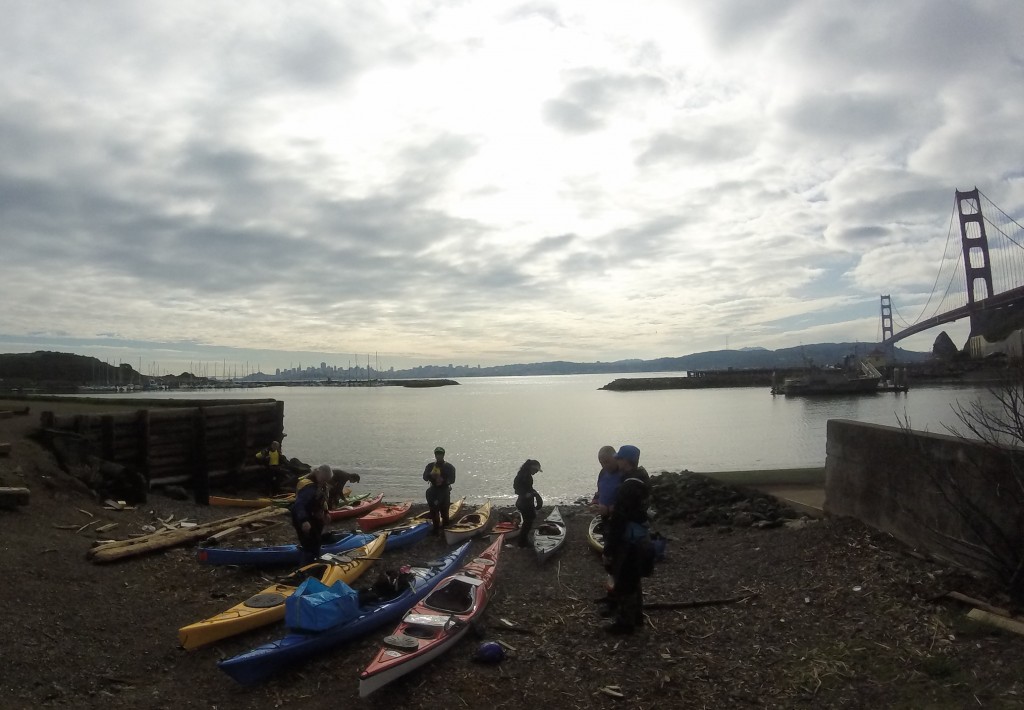As a beginner to sea kayaking, you might be wondering where to start -- that's where we come in. With years of sea kayaking instruction under our belt, we've got the answers to your burning questions and beginner kayaking tips to set you on course.
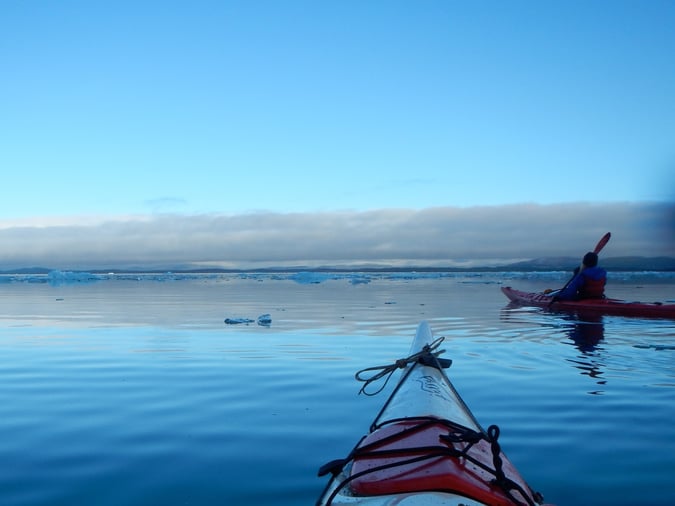 Photo by Julie Rice
Photo by Julie Rice
With NOLS, you'll not only develop essential beginner kayaking skills from paddling techniques to navigating the coastline with grace and efficiency, but you'll also have the opportunity to form a profound connection with nature, expand your leadership capabilities, and forge enduring bonds with your "pod" members.
Whether you're a whitewater kayaking adventurer eager to trade in those whitewater rapids for saltwater waves, a sea kayaking hobbyist ready to level up your skills, or completely new to kayaking in all forms, get ready to hone in on the fundamentals with our sea kayaking expeditions.
Is Learning How to Sea Kayak Worth It?
For beginner kayakers, the lists of terms, gear, and skills related just to the fundamentals can seem overwhelming, but rest assured that sea kayaking is not only a fairly accessible skill to learn, it's also a skill that grants you access to the coolest locations and a slew of abilities that can be leveraged in all areas of life.
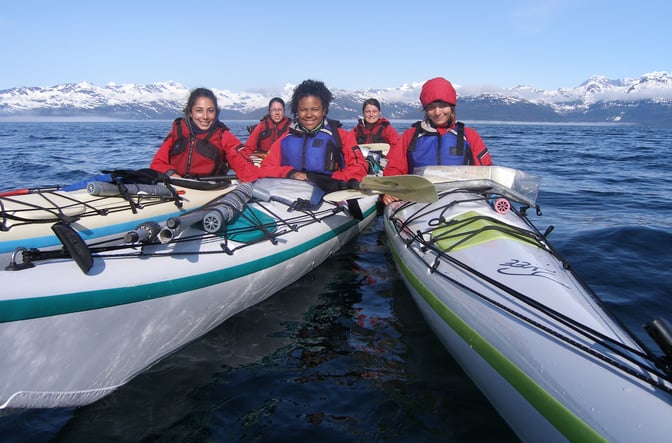 Photo by Tracy Baynes
Photo by Tracy Baynes
Gain Access to Unique & Adventurous Destinations
At NOLS, the sea kayak serves as a mechanism for wilderness exploration. Our expeditions open doors to extraordinary destinations, providing opportunities to connect intimately with nature and witness vibrant wildlife in new and unique ways.
Each sea kayaking destination promises a thrilling adventure and a unique tapestry of landscapes, wildlife, and conditions that make every stroke an immersion into the wonders of nature.
Sea Kayaking in Patagonia
In the rugged beauty of Patagonia, participants navigate steep-sided fjords that carve through the heart of a pristine wilderness. Gliding through these majestic waterways, you might encounter colonies of penguins, witness sea lion rookeries, or experience the exhilarating sight of sea lions swimming alongside your kayak. The skies are adorned with the majestic presence of albatross, while the ever-changing conditions add an element of unpredictability to the journey.
Sea Kayaking in Baja
Baja, with its enchanting coastlines, offers a kaleidoscope of marine life. As you paddle, be prepared to witness flying fish gracefully soaring above the water, sea turtles gliding beneath the surface, and the majestic presence of whale sharks and manta rays. As the sun sets, the sea comes alive with bioluminescence, transforming the waters into a mesmerizing display of natural light. Amidst this, the surrounding desert landscape adds a stark and stunning contrast to your sea kayaking adventure.
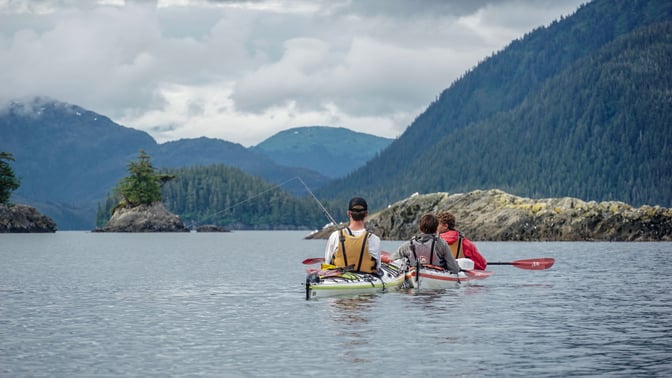 Photo by Jack Kirkpatrick
Photo by Jack Kirkpatrick
Sea Kayaking in Alaska
In the vast wilderness of Alaska, participants navigate through tide-water glaciers, marveling at their majestic beauty. The waters are teeming with life as humpback whales breach the surface, orcas glide through the depths, and sea lions playfully frolic in the surrounding waves. Sea otters bob in and out of view amongst the waves, adding a charming touch to the rugged Alaskan seascape.
Sea Kayaking in New Zealand
New Zealand, with its diverse ecosystems, provides a canvas for an unforgettable sea kayaking experience. NOLS runs courses in the Marlborough Sounds, renowned for its remarkable wildlife such as penguins, whales, and dolphins. As evening descends, you'll camp on secluded beaches nestled against lush forests, drifting into slumber to the soothing melody of gentle waves caressing the shore.
Whichever destination you choose, a NOLS sea kayak course promises not just a paddling adventure but an exploration of nature's wonders in some of the most secluded corners of the world. It's an opportunity to connect with the environment, witness wildlife in its natural habitat, and forge lasting memories in the midst of these remote and untamed landscapes.
Learn Self-Leadership and Quick Decision Making Skills Through Paddling
Beyond exploring vast oceans and coastlines, NOLS sea kayaking courses foster team-building and self-confidence among beginners and seasoned kayakers alike.
The teamwork required to navigate coastal waters and practice essential rescue techniques with those in your "pod" helps you develop strong communication skills, adaptability, and trust—essential qualities for effective self- and group-leadership.
Our sea kayak courses strike a perfect balance between adventure, personal growth, and enjoyment, providing an opportunity to enhance your skills and broaden your perspectives in some of the world's most remote and stunning locations.
Sea Kayaking Terminology for Beginner Kayakers
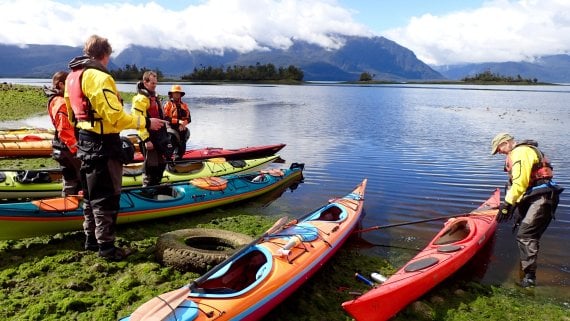 Photo by Jordan Cranch
Photo by Jordan Cranch
Developing basic knowledge and key terminology will help you communicate effectively with other kayakers when preparing to embark on your first sea kayaking trip. Familiarize yourself with these key sea kayaking terms to get you started:
Kayak Design and Components
- Sea Kayak: Compared to whitewater kayaks, sea kayaks are longer and narrower, designed for open water and coastal environments with features like bulkheads and hatches for extended kayaking trips. Sea kayaks prioritize tracking (maintaining a straight course) and efficiency for covering longer distances. Whitewater kayaks are shorter and more maneuverable, built for navigating fast-flowing rivers.
- Bulkhead: A compartment inside a kayak that creates a sealed compartment, often located near the bow and stern.
- Cockpit: This opening allows kayakers to sit inside kayaks.
- Deck Lines: Rigging on the kayak deck that is used for securing gear, providing handholds, and assisting with rescues.
- Hatch: A watertight compartment on a kayak, sealed with a hatch cover, used for storing gear and providing buoyancy.
- Kayak Paddle: A double-bladed paddle used by kayakers for propelling and steering their kayaks through the water. The kayak paddle comprises a paddle shaft and two paddle blades, one on each end of the shaft.
- Rudder: A movable fin or blade, often controlled by foot pedals, used to aid in steering the kayak.
- Skeg: A retractable fin near the stern of the kayak, used to improve tracking by reducing the impact of wind and current. Most sea kayaks have either a rudder or a skeg.
- Spray Skirt: A waterproof cover worn by the paddler that attaches to the cockpit. The spray skirt prevents water from entering the kayak cockpit while the kayaker paddles.
Paddling Technique Terms
- Forward Stroke: The primary paddling technique for propelling the kayak forward efficiently.
- Reverse Stroke: Paddling in the opposite direction of a forward stroke to slow down, stop, or move backward.
- Sweep Stroke: A wide, sweeping paddle stroke used to turn the kayak.
- Draw Stroke: A stroke used to pull the kayak sideways, useful for tight turns or moving parallel to an object.
- Sculling Stroke: A technique where the paddle blade is moved back and forth in the water to provide support or maintain balance.
- Bracing: A paddling technique used to prevent capsizing by using the paddle for support against the water.
- High Brace: A bracing technique with the paddle held horizontally above the water to prevent a capsize.
- Low Brace: A bracing technique with the paddle blade held horizontally close to the water's surface to maintain stability.
- Edging: The technique of tilting the kayak by shifting one's body weight, influencing the kayak's direction and stability.
Emergency Response and Rescue Terms
These techniques cover a range of emergency response and self-rescue methods, enhancing a kayaker's ability to handle various challenging situations on the water. While self-rescue techniques are essential for all kayakers to be proficient in, we advocate for a proactive approach to avoiding high-risk conditions.
While our courses prioritize the development of essential sea kayak self-rescue techniques, we also note that these skills should not be relied upon or used as an excuse to attempt sea kayaking in high-risk conditions. For a deeper overview of sea kayak self-rescue techniques, join us in one of our sea kayaking expeditions and courses.
- Self-Recovery Techniques: Skills used by kayakers to recover from a capsize and re-enter the kayak without assistance.
- Wet Exit: The process of intentionally exiting the kayak while in the water, typically performed in training for self-recovery scenarios.
- Re-entry: The process of getting back into the kayak from the water, a crucial skill in capsize situations.
- Assisted Rescue: Techniques where kayakers help each other recover from a capsize and re-enter the kayak.
- Towing: The method of using a tow line to assist or be assisted by another kayaker during a rescue situation.
- Scoop Rescue: A rescue method involving the assisting paddler using their kayak like a scoop to help the capsized paddler re-enter.
- X Rescue: A rescue technique involving two kayakers forming an "X" shape to stabilize and assist a capsized paddler.
- Paddle Float Rescue: Using a paddle float to create additional buoyancy for self-rescue or assisting others.
- Stirrup Rescue: A method of assisting a paddler in re-entry by using a stirrup or step to make the process easier.
- Cowboy Rescue: A self-rescue technique where the paddler flips the kayak upright and quickly climbs back in without assistance.
- Bilge Pump Use: Using a handheld bilge pump to remove water from the kayak after a capsize or wet exit.
Essential Kayaking Gear for Beginner Kayakers
In addition to the sea kayak and paddle mentioned above, the following kayaking gear items are must-haves for every beginner kayaker and seasoned paddler alike.
-1.jpg?width=672&height=446&name=Kayaking%20(1)-1.jpg) Photo by NOLS
Photo by NOLS
Essential Kayak Gear
- PFD (Personal Flotation Device): This indispensable piece of gear serves as a personal buoyancy aid, functioning much like a life jacket. Worn by kayakers, the Personal Flotation Device enhances personal well-being while navigating the water and reduces the risk of drowning in case of capsize.
- Handheld Pump: A pump is a critical tool for efficiently removing water from a kayak after a capsize. Travel with the pump in a place that is secure and easy to access quickly.
- Paddle float: These are used to aid in self-rescue or to help another paddler get back in their boat. Sea kayaking paddle floats usually come in two styles: inflatable or foam. The inflatable floats take up less space. The foam floats can be a bit faster to use for novice paddlers. Travel with the paddle float in a secure and accessible location on your boat.
- Spare paddle: A spare paddle is necessary in the event of a capsize where you lose control of your paddle.
- Light source: Sea kayaks are low-profile vessels making them hard for larger boats to see. It is crucial to have a light source when navigating in conditions of darkness or low light. International COLREGS (Convention on the International Regulations for Preventing Collisions at Sea) asserts that white light is mandatory for nighttime operations, but it doesn't necessarily need to be continuously active—simply accessible when required.
- Marine flares: Marine flares are an efficient way to signal distress at sea. Make sure your flares are stored safely and check the expiration date before each trip.
- Tow rope (if traveling with another boat): Waist belt tow ropes with a quick release make it easy to tow another boat in need. The quick-release feature allows you to disconnect from the other boat in an emergency.
- Sound signaling device: A whistle is helpful for communicating with other paddlers. Coast Guard regulations may require paddlers to carry a sound signaling device that can be heard by other, often larger, boats.
- VHF Radio: A fundamental communication tool, the VHF radio is an essential component of sea kayaking. Used for both routine communication and emergency purposes on the water, it enables kayakers to stay connected with fellow participants and instructors, facilitating the swift initiation of rescue procedures if necessary.
- Wetsuit: Wetsuits are typically crafted from neoprene material for thermal insulation in cold water environments. The wetsuit's innovative design allows a thin layer of water to enter and form a warm buffer against the body, providing comfort and warmth in chilly waters. Note: Wetsuits are optional! They can be expensive and wearing a wetsuit can be avoided if you are deliberate about the kinds of conditions you paddle in (warmer water, mild conditions, with a partner instead of alone).
- Drysuit: Unlike the wetsuit, which provides insulation via a layer of water, drysuits are designed to use air insulation to keep the kayaker warm and dry. The drysuit is a waterproof, full-body garment that kayakers wear to stay dry in cold water conditions. This protective layer is crucial to maintaining body warmth and comfort during extended paddling sessions, particularly in cooler climates. Note: Drysuits are optional! They can be expensive. Purchasing and wearing a drysuit can be avoided if you are deliberate about the kinds of conditions you paddle in (warmer water, mild conditions, with a partner instead of alone).
A Deeper Look at Technical Skill Development With NOLS
Foundational Paddling Techniques
Embarking on a sea kayaking adventure is an immersive experience, and at NOLS, we understand that the journey begins with mastering the art of paddling.
Our comprehensive sea kayaking courses place a strong emphasis on developing foundational techniques needed to paddle correctly and form the bedrock of your skills.
1. Forward Stroke Proficiency
The forward stroke is the engine that propels your kayak forward, and at NOLS, you'll practice and become proficient in the basics. Instructors guide you through the nuances of a powerful yet efficient forward stroke, teaching you techniques to help each paddle stroke maximize your speed and minimize energy expenditure. You'll learn the proper torso rotation, paddle placement, and follow-through techniques contributing to a smooth and efficient glide through coastal waters.
2. Corrective Strokes to Regain Control
Navigating through currents, winds, and varying water conditions demands a repertoire of corrective strokes. Our courses focus on developing corrective techniques such as sweep strokes, draw strokes, and rudder strokes. These strokes enable you to maintain control, make precise turns, and navigate through obstacles with finesse.
Understanding the dynamics of each corrective paddle stroke is fundamental to becoming a skilled sea kayaker, and our instructors provide hands-on guidance to help you grasp these techniques effectively.
3. Bracing Techniques for Stability
Maintaining stability on the water is important in preventing capsizing, especially when faced with unexpected challenges. NOLS sea kayaking instructors teach essential bracing techniques that enhance your ability to recover from a potential capsize.
Whether it's a low brace for maintaining balance in choppy waters or a high brace for stability in turbulent conditions, you'll develop the muscle memory and confidence needed to keep your kayak upright.
4. Efficient Maneuvering with Edging
Edging is a nuanced skill that adds a layer of finesse to your paddling. Our instructors guide you through the art of edging your kayak, allowing you to tilt it slightly to one side.
This technique enhances your maneuverability, enabling you to turn more efficiently and navigate through tight spaces with ease.
With practice, you'll gain a deeper understanding of how your kayak interacts with the water in various positions, contributing to a more intuitive and enjoyable paddling experience.
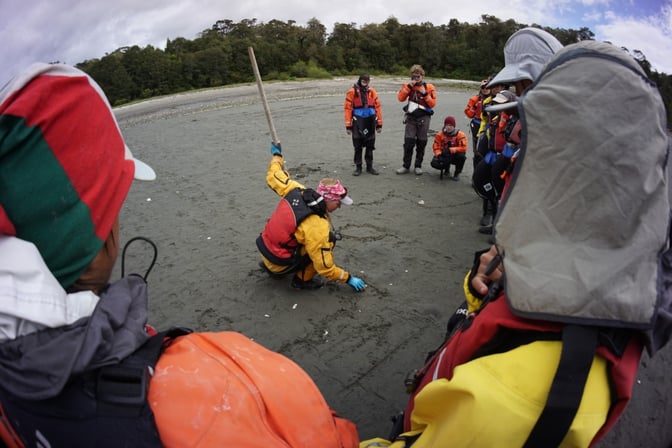 Photo by Oscar Manguy
Photo by Oscar Manguy
Coastal Navigation Basics
What's awesome about NOLS sea kayaking expeditions, in particular, is that you'll get to use sea kayaking to explore the wildest, most beautiful, and remote coastal locations on our planet.
During a NOLS sea kayaking course, you will learn key coastal navigation skills that help you explore these locations more effectively.
Additionally, navigating in the challenging coastal environment will develop your communication, decision-making, and problem-solving abilities. As you become more proficient in coastal navigation, you'll gain confidence in your ability to help your pod plan routes, estimate travel times, and adapt to changing weather conditions.
Our focus on these essential navigation skills will provide a solid foundation for further sea kayaking adventures and recreational paddling along various coasts.
1. Chart Reading and Interpretation
Navigating coastal waters begins with the ability to read nautical charts accurately. NOLS courses provide a comprehensive understanding of the symbols, contours, and annotations found on these charts.
Instructors guide participants through the intricacies of chart reading, empowering them to interpret information crucial for coastal navigation. From identifying underwater features to understanding depth contours, you'll gain the skills needed to navigate effectively along the coastline.
2. Tidal Dynamics and Planning
Tidal patterns play a significant role in coastal navigation, influencing water depth, current strength, and potential hazards. NOLS courses immerse participants in the study of tidal dynamics, teaching you how to read tide tables and predict tidal movements.
Understanding the ebb and flow of tides becomes essential for planning routes, exploring tidal zones, and effectively navigating through shallow areas. This knowledge is a key component of becoming a confident coastal kayaker.
3. Route Planning for Coastal Exploration
Planning a route along the coastline also involves taking a strategic approach that considers currents, wind patterns, and potential points of interest.
With NOLS, you'll learn key route-planning skills like how to identify suitable landing sites, plan for potential challenges such as headwinds or tidal currents, and create a comprehensive navigation plan that maximizes the enjoyment of your coastal journey.
4. Practical Application through Coastal Expeditions
At NOLS, we believe in learning by doing. Our courses incorporate practical coastal expeditions, allowing participants to apply their navigation skills in real-world scenarios. Whether paddling through rocky coves, exploring hidden inlets, or navigating around coastal features, you'll have the opportunity to put your coastal navigation knowledge into practice, reinforcing the skills acquired in the classroom.
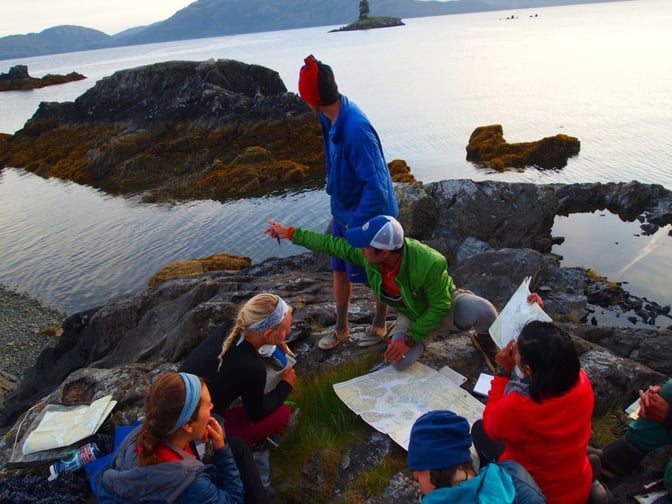 Photo by Maija Pukkila
Photo by Maija Pukkila
Reading the Elements: Water and Weather Conditions
Embarking on a sea kayaking adventure involves not only navigating through water but also understanding the ever-changing dynamics of weather.
Learning how to interpret water and weather conditions properly is essential when it comes to assessing risk conditions and creating enjoyable experiences on the open sea.
Our courses start with the basics and go beyond, equipping you with the skills needed to read the elements and make informed decisions while paddling.
1. Interpreting Water Conditions
Understanding the language of the water is fundamental for any sea kayaker. Our instructors provide you with insights into interpreting water conditions, whether it's deciphering the movement of currents, recognizing wave patterns, or identifying potential hazards beneath the surface. By developing a keen awareness of water dynamics, you'll be better equipped to navigate with confidence and awareness in various coastal environments.
2. Weather Awareness and Forecasting
Navigating the open sea requires a solid understanding of weather patterns and the ability to anticipate changes. Delve into the principles of weather systems and learn to interpret cloud formations, wind direction, and barometric pressure.
With the hands-on experience of a NOLS course, you'll gain the skills needed to analyze weather forecasts, make real-time assessments, and plan your sea kayaking adventures based on current and forecasted weather conditions.
3. Wind and Its Impact on Paddling
Wind is a significant factor in sea kayaking, influencing both the difficulty of paddling and the risk conditions of your journey. NOLS courses provide insights into the effects of wind on kayaks, teaching techniques to paddle efficiently against headwinds and harnessing the wind for assistance when needed.
Understanding wind patterns and their impact on the water is essential for making strategic decisions during your sea kayaking expeditions.
4. Coastal Microclimates
Coastal environments are renowned for their diverse microclimates, where conditions can vary significantly over short distances. NOLS courses highlight the importance of recognizing and adapting to coastal microclimates.
Whether paddling along cliffs, through sheltered coves, or across open bays, participants learn to navigate these dynamic environments with an understanding of how microclimates can influence wind, temperature, and overall weather conditions.
5. Decision-Making in Changing Conditions
Risk management is paramount in sea kayaking, and at NOLS, we emphasize the importance of making informed decisions based on changing water and weather conditions.
Participants learn to assess risk factors, modify their plans when necessary, and prioritize well-being without compromising the enjoyment of their journey. Our instructors guide you through practical scenarios that simulate changing conditions, allowing you to practice informed decision-making in a controlled environment.
Beginner Kayaking Tips: Getting Ready for Your First Sea Kayaking Trip with NOLS
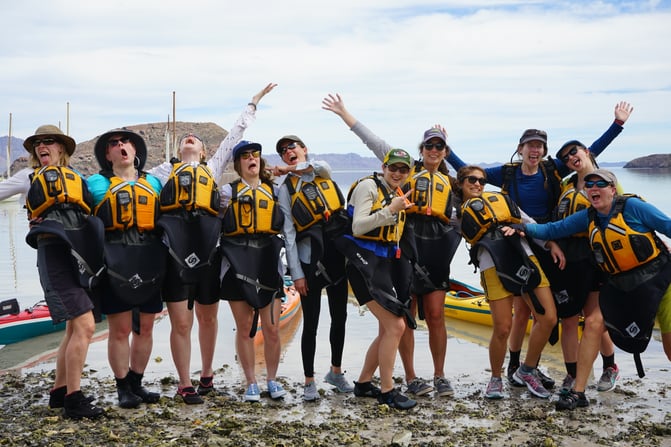 Photo by Lynn Petzold
Photo by Lynn Petzold
Mental and Preparation for Beginner Sea Kayakers
Embarking on your first sea kayaking trip is an exciting venture into the realm of adventure and personal growth. To set yourself up for a rewarding experience, consider these beginner kayaking tips to help you prepare. Preparing both physically and mentally will not only enhance your enjoyment but also set the stage for a successful journey into the world of sea kayaking.
Physical Readiness
Preparing for your first sea kayaking expedition with NOLS doesn't demand the same aerobic threshold as backpacking or climbing.
Unlike these activities where speed may be influenced by individual fitness levels, sea kayaking relies more on efficient paddling techniques than sheer strength or typical fitness markers. Fast backpackers often find themselves paddling at a similar pace to everyone else, emphasizing that success on the water is more about mastering the right techniques than pushing physical limits. To prepare yourself physically, engaging in simple movement exercises should be enough.
At NOLS, we start by prioritizing practice sessions in calm, shallow water to help you familiarize yourself with efficient paddling movements, allowing your muscles to adapt and enhance their memory for the journey ahead.
By emphasizing technique over sheer strength, you'll discover that sea kayaking is an accessible and enjoyable adventure for individuals of various fitness levels.
Adopting a Growth Mindset
Approach your first sea kayaking trip with a growth mindset—a willingness to embrace challenges, learn from experiences, and celebrate the process of improvement. Sea kayaking may present moments of uncertainty, especially for beginners, but viewing these challenges as opportunities for learning can turn obstacles into achievements.
Some tips for adopting a learner's mindset include:
- Be open to new experiences and willing to try new techniques.
- Accept feedback from your course leaders and fellow participants.
- Focus on the present moment and soak in the natural beauty of the environments you paddle through, such as hidden coves and star-filled skies.
Embrace the learning curve with enthusiasm. Cultivate patience and resilience, recognizing that growth often occurs outside of your comfort zone. The more open you are to new skills and experiences, the more rewarding and transformative your sea kayaking journey will become.
Start Planning Your First Kayaking Trip in Coastal Waters
Unleash the paddler in you, explore the beauty of coastal waters across the world, and discover the incredible potential that sea kayaking holds for your mind, body, and soul.
Your adventure begins now—explore NOLS sea kayaking expeditions and make waves in the world of sea kayaking!
FAQs
What essential skills do I need to learn before starting sea kayaking?
As a beginner, you will need to learn basic paddling techniques, understanding of tides and currents, navigation, and self-rescue procedures. Sea kayaking is relatively easy to learn, and with proper instruction, you'll develop confidence quickly. When you join a NOLS course, we'll teach you these essential skills to help you prepare for your sea kayaking adventure.
How does participating in a NOLS course prepare me for sea kayaking?
A NOLS course emphasizes personal growth, leadership development, risk management, and environmental stewardship. Along with teaching technical sea kayaking skills, our instructors focus on developing your leadership abilities. Paddling serves as a mechanism for exploring remote and captivating locations. We tailor our lessons to your skill level, making the courses accessible to total beginners and more experienced students alike.
What are the precautions to consider when attempting sea kayaking as a beginner?
While embarking on a sea kayaking journey, it's essential to consider risk management. As a beginner, you should be accompanied by experienced kayakers or instructors who will guide you in assessing potential risks and applying proper risk mitigation strategies. NOLS strongly emphasizes risk management and awareness in our courses, giving you confidence in making informed decisions while out on the water.
What are the physical requirements for new kayakers embarking on ocean kayaking?
Sea kayaking requires a moderate level of physical fitness, as you'll be paddling for extended periods and potentially encountering changing weather conditions. You'll also need strength and flexibility to execute various paddling techniques. As you embark on a NOLS course, we'll guide you through proper technique and help you develop the necessary physical abilities for a successful sea kayaking experience.
How long does it typically take for a novice to comfortably handle a kayak in the sea?
The time it takes for a novice to feel comfortable handling a sea kayak depends on the individual's learning pace and prior experience. However, with proper instruction and practice, many beginners can become confident in handling a kayak within a few days. By participating in a NOLS course, you'll receive comprehensive instruction, practice in real-life conditions, and ongoing support to help you build confidence and proficiency in sea kayaking.
Written By
NOLS
NOLS is a nonprofit global wilderness school that seeks to help you step forward boldly as a leader.


